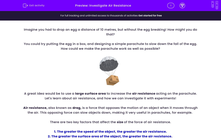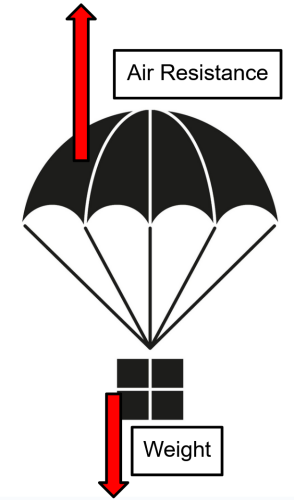Imagine you had to drop an egg a distance of 10 metres, but without the egg breaking! How might you do that?
You could try putting the egg in a box, and designing a simple parachute to slow down the fall of the egg. How could we make the parachute work as well as possible?
.jpg)
A great idea would be to use a large surface area to increase the air resistance acting on the parachute. Let's learn about air resistance, and how we can investigate it with experiments!
Air resistance, also known as drag, is a force that opposes the motion of an object when it moves through the air. This opposing force can slow objects down, making it very useful in parachutes, for example.
There are two key factors that affect the size of the force of air resistance.
1. The greater the speed of the object, the greater the air resistance.
2. The greater the surface area of the object, the greater the air resistance.
We will discuss an experiment that could be carried out to investigate the link between the surface area of a parachute and the air resistance of that parachute.
In our experiment, we will be dropping boxes from a set height of 10 metres, and timing how long it takes for the box to reach the ground. We will repeat the experiment with multiple sizes of parachute.
The longer it takes for the box to reach the ground, the greater the air resistance must have been.
In this investigation, the independent variable will be the surface area of the parachute. This is the independent variable as we will be changing it each time, to see what effect it has on the results.
The dependent variable will be the time taken for the box to reach the ground. This is the dependent variable because it is what we will measure each time, and will change as a result of the independent variable.
What are control variables? What should our control variables be in this experiment?
Control variables are variables that we keep constant, to make the experiment a fair test. An experiment is a fair test if only one variable, the independent variable, affects the outcome.
What should our control variables be?

1) The same shape of parachute each time (square, with holes in the corners to attach strings between the parachute and box).
2) The same material for the parachute each time.
3) The same height we drop the box from each time.
4) The same box to be dropped, with the same mass.
The experiment is carried out, and results can be recorded in a table like this:
| Surface Area (cm2) | Time Taken (s) |
|---|---|
| 0 (no parachute) | 1.4 |
| 20 | 2.0 |
| 40 | 2.3 |
| 60 | 3.1 |
| 80 | 3.5 |
We can conclude that the surface area of the parachute did affect the time taken to fall. The greater the surface area of the parachute, the greater the time taken for the box to fall.
Let's have a go at the questions now.









